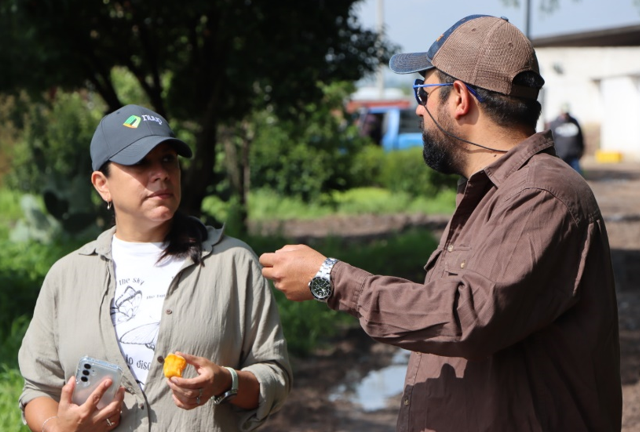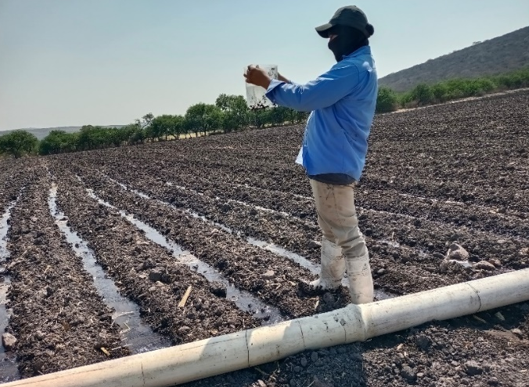Esther Camacho Guerrero – Director of the Regenera Bajío Program, Nuup.
In Mexico, like many other countries, the agricultural sector is the main consumer of water. According to INEGI data, it accounts for over 67% of the total volume used nationwide. This figure highlights the urgency of implementing sustainable water management strategies, especially in a context of growing water crisis.
The country’s water security is closely linked to the agricultural sector’s ability to adapt and make more efficient use of the resource. Especially small-scale agriculture, which occupies about 72% of Mexico’s agricultural territory, still heavily relies on gravity irrigation systems, also known as furrow or flood irrigation. These systems have an estimated efficiency between 20% and 40%, leading to significant water loss, often groundwater, which could be better utilized.
Optimizing Irrigation is Possible: Experience from the Field
At Regenera Bajío, we work with producers to improve irrigation practices and move towards effective water conservation. We have proven in the field that, with adequate technical advice and commitment from the producer, efficiencies of up to 80% can be achieved. This translates into less water extraction, reduced costs, prevention of agricultural diseases, and, in many cases, improved productive yields.
But beyond tools and technologies, the key to change lies in the human factor. The experience, knowledge of the territory, and willingness of producers are fundamental to achieving a transition towards more sustainable agriculture.
A People-Centered Methodology
Aware of the particularities of the Mexican countryside, we developed an intervention approach centered on the producers. Our team provides personalized technical advice, with field visits that allow us to analyze the specific conditions of each plot: soil type, slope, crops, availability of irrigation infrastructure, and access to water.
Through interviews and direct observation, we analyze current practices:
- How do they irrigate?
- When and how often?
- Why is that system chosen?
With this information and data measured on the ground, we propose practical and accessible adjustments, such as modifications to irrigation scheduling, valve installation, or small leveling works. These changes, adapted to the producer’s reality, usually have an immediate and significant impact on water use efficiency.
Changing Deep-Rooted Habits: A Cultural Challenge
One of the most relevant challenges is modifying habits that have been passed down from generation to generation. Many producers repeat irrigation routines because “that’s how it’s always been done,” even if they are not always the most suitable for the current climatic and environmental reality.
Therefore, our approach prioritizes close accompaniment, establishing relationships of trust from the beginning of the process. Listening to their doubts, responding with technical evidence, and respecting their timelines are key to generating lasting transformations.
We also promote the active participation of producers in recording field data. This exercise allows them to observe for themselves the results of the implemented improvements, which reinforces evidence-based decision-making and empowers communities to care for their resources.
Reusing Knowledge: A Virtuous Cycle
Another essential aspect of the methodology is returning the information generated in each agricultural cycle to the producers. This not only improves water management in their productive units but also strengthens the collective memory of the territory.
Furthermore, water efficiency becomes a gateway to other key issues, such as aquifer recharge, water quality, or even the relationship between agriculture and the restoration of aquatic ecosystems. Water that is not wasted in the field is water that can be kept in rivers, wetlands, or natural reservoirs.
Training, Community, and Local Solutions
Training is a transformative tool. Therefore, we organize group workshops in the communities where we work, addressing topics such as:
- Current water challenges in Mexico.
- Rights and obligations of producers.
- Tools for measuring soil moisture.
- Alternative irrigation systems and their maintenance.
- Successful cases of transition to sustainable agriculture.
These spaces not only generate knowledge but also strengthen community ties and foster the exchange of solutions that arise from the territory.
Beyond Water: Towards Regenerative Agriculture
Improving irrigation efficiency is just the first step. At Regenera Bajío, we seek to generate a systemic impact, where water security is articulated with climate resilience, rural well-being, and the agroecological transformation of the Mexican Bajío
This implies moving towards productive systems that:
- Contribute to aquifer recharge.
- Prevent the contamination of water bodies.
- Strengthen community water projects.
- Integrate into watershed management.
- Respect natural water cycles.
Conclusion: Alliances for the Future of Water
In the face of the water crisis, we need concrete, scalable, and just solutions. Irrigation efficiency is not just a technical goal: it is a key strategy to ensure water today and tomorrow. But to achieve it, technology is not enough. It requires knowledge, accompaniment, and, above all, trust in the transformative capacity of the producers.
At Regenera Bajío, we continue to bet on this path: one that unites knowledge, promotes collective learning, and cares for water as the common good it is.
Learn more at https://aguasegura.com/


